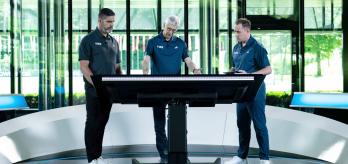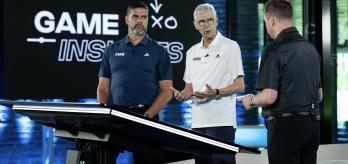In this episode of Game Insights, Chris Loxston (Group Leader, Football Performance Analysis & Insights), Arsène Wenger (Chief of Global Football Development) and Tony Colbert (FIFA Technical Expert) delve deep into the use of the wing as a means of creating goal-scoring opportunities. Together, they reveal a variety of options unique to playing out wide, beginning with the basics of attacking in those areas. They then move on to discuss the relationship between wide players and full-backs, dealing with cut-backs and exploiting the half-spaces created out wide. A good grasp of all of these can guarantee that coaches and players alike can realise wing play's full potential.
Part 1: Introduction of topic and guests
00:50
Tony Colbert's role at Arsenal I
Tony Colbert joined Arsenal in 1998, where he was initially responsible for fitness and conditioning. During his early years at the club, he developed a good relationship with assistant coach Boro Primorac, with whom he worked closely.They actively pursued the idea of redeveloping the technical – physical training relationship, by combing technical training with physical training, whilst always involving the ball. as an effective way to improve the team.
01:48
Tony Colbert's role at Arsenal II
Tony developed a great interest and expertise in the physical aspects of the game. Over time, he applied his work in this area to the technical side of the sport, redeveloping technical training so that it would always have a physical goal. The merging of these two elements impressed Arsène Wenger, who encouraged Tony to develop a repertoire of exercises of this nature. The method is summarised nicely by Arsenal's warm-up at the time: while warming up at most clubs typically consisted of 15 to 20 minutes without touching the ball, in Arsenal's warm-ups, players could sometimes touch the ball up to 200 times.
Part 2: Basics of attacking wide areas
00:38
The necessity of playing wide
"The modern game closes down the centre of the pitch [making it often congested and difficult to play through]. This gives more freedom on the flanks. For the attacking team, there are [conventionally] two different options to break the opponent's last line: go to the sides or go over the top. But you can also go over the top on the sides. We will take a closer look at this variety of possibilities that you can offer on the flanks." (AW)
01:49
Phases of attacks from the wing
Ideally, this type of attack will consist of multiple phases before the ball hits the back of the net. Firstly, the ball is circulated centrally via passing triangles, which lures the opposition in and creates more space on the flanks (especially the side furthest away from the ball). Secondly, the ball is moved quickly to a wide player in space on the opposite side, who breaches the defensive line to enter the final third. Lastly, the ball is then crossed into the box, where a strong presence of attacking players (all making coordinated runs) look to finish the attack.
02:47
Treating the cross as a final ball
In the modern game, where and how a player crosses is important. To ensure a high-quality delivery, you need to work on crosses in training and create a mindset whereby every cross is treated as a final ball. Wide players have to practise under pressure on the flanks while still being aware of where their team‑mates are when they cross and of where they are crossing the ball from.
03:56
Sweden v. Germany (FIFA Women’s World Cup France 2019™)
Sweden start by building up on the left and then bringing the ball through the lines into the middle. Here, the receiving player turns quickly and plays wide, creating a one-on-one on the right flank. The player decides to cross into the box, delivering the ball well to the far post and Sweden score from the rebound.
04:20
1v1 on the wing
The 1v1 is a key basis of team play. The ability to get past the player in front of you is something that needs to be mastered in all team sports. On the wing, the player needs to show their confidence by taking on the defender and crossing the ball into the box.
06:37
Presence in the box
An attacking team needs a good number of players in the box to make sure it can finish an attack from the flank. This clip is a clear example: because of Sweden's presence in the box, they were able to score from the rebound.
Part 3: The relationship between wide players and full-backs
00:25
Overlapping runs
Because of the effectiveness of the overlap as an attacking threat, it is vital that full-backs and wide players have a good understanding with each other. Their partnerships are predominantly based on timing. If the full-back and wide player are in sync, the wide player can drift inside at precisely the right moment and play in the overlapping full-back when they are in full stride.
01:22
The modern full-back
"First and foremost, they have to be able to get up and back. That's the absolute necessity. The timing is also crucial. They need that instinct to feel when that ball is going to come. Then they need to go with full power and vigour, whilst having eyes on their team-mates… [For physicality,] you need to train them to get a cross in, get back in position and repeat. If they can’t do this, they won’t make it at the top level." (TC)
07:22
Spain v. Tajikistan (FIFA U-17 World Cup Brazil 2019™)
The centre-back passes through the opponent's midfield and the receiver turns well with his first touch and passes to the opposite side. The run, quality and timing of the pass to the overlapping full-back are smoothly executed. In addition, Spain have a strong presence in the box with five players.
11:22
Rotating inside
There are two ways of rotating inside to create additional space on the wing. The first is when the wide player moves inside and creates space for the full-back to push forward into the space they have left. The second is when the full-back runs inside, drawing the opposition in with them, which creates more space for the wide player on the wing. Both are movements that help players reach dangerous areas of the pitch.
12:47
Netherlands v. USA (FIFA U-17 World Cup Brazil 2019)
The US team is defending compactly, when the Netherlands left-winger comes inside and opens the space for the full-back, who makes a good run down the wing. The central midfielder delays slightly and plays the ball into the run at the right moment. The full-back then cuts it back and it reaches the striker at the far post, who scores with a first‑time shot.
15:20
Defending cut-backs
Cut-backs are so dangerous because when they occur, the defenders are running towards their goal at top speed, making it necessary to look in that direction as well, meaning they cannot be aware of what is happening behind them. That is why it is essential that the midfielders help by tracking back in these situations.
Part 4: The threat of cut-backs
00:08
France v. Netherlands (FIFA U-17 World Cup Brazil 2019)
The French midfielders try to find an opening against a Netherlands team with ten men behind the ball. Although the passing is a bit slow, they take advantage of the fact that the wide player is not completely cutting out the through-ball on the flanks, as there is too great a gap between him and the full‑back. With the Netherlands midfielders failing to track back sufficiently after the through-ball is played, the French score.
01:00
The importance of positioning
France exploit the gap that opens up on the right as a result of the outermost Dutch player not following the backline across to the left. It is noteworthy that although ten players are in their own half, one individual positional error is enough for the attackers to get into a promising position. It is also necessary to have players who can recognise, run into and play in these spaces in order to take advantage of a situation.
02:56
Anticipating the cross
It should have been possible for at least one centre-back to step out to defend the cut-back, as only one player is needed at the far post to deal with the low cross. For this, however, it is important to be able to anticipate the exact moment when the ball will be played across. Since this does not happen, France score even though they are outnumbered in the box.
Part 5: Exploiting the half-spaces
0:10
Brazil v. Canada (FIFA U-17 World Cup Brazil 2019)
The Brazilian right-back dribbles from the wide area into the inside-right channel, underlapping his striker. The striker's movement out wide makes him available for the right-back. They then combine with a series of passes on the edge of the box, culminating in the striker taking on three defenders and cutting it back to an oncoming midfielder.
00:51
The space between full-back and centre-back
The zone between the wing and the centre, on the edge of the box, is important for attackers in the modern game. Because the opponents' centre-back near the ball is covering the goal and the full-back near the ball has to move out to block the player in possession, there is a large space created between the two defenders for the attackers to exploit. Defending this space needs the support of midfielders.
03:05
Behaviour in the box
In the box, the attacker is king. Players know that they have special protection when inside the opponents' penalty area and take advantage of it by taking defenders on and only leaving the box if they have to. After all, just one touch from an opponent may earn them a penalty.
03:32
Finishing
Some 80% of goals are one-touch finishes. However, if there is no clear goal-scoring opportunity, it is better to look for a team-mate who is better placed to score rather than trying to force an impossible shot.
03:58
Mexico v. Solomon Islands (FIFA U-17 World Cup Brazil 2019)
With the pass to the left-back, Mexico's left winger already knows that the ball will be played over the opponent's backline. While he prepares his deep run by taking a few steps forward and back again, he has his ball-carrying team-mate in sight the whole time. At the right moment, he finally picks up speed to run in behind, giving him an advantage when the ball is played. His marker needs to turn and has already lost five metres.
06:00
Passes behind the defence
If the ball is played well behind the backline, defenders have real problems in dealing with the action that follows. They have to close the distance to their own goal first – at top speed – which leaves little time in which to organise themselves.
07:15
Training anticipation
Due to the tendency towards high pressing, defenders have to move up wide in today's game. It is therefore worth preparing the wingers specifically for such situations in training. This way, they can anticipate the long balls in behind and exploit the chances that arise from them.
Part 6: Final thoughts
00:22
Key points of exploiting wide areas I
"I would say again it is down to combinations, timing of combinations, and triangles created by the central players. One important thing we have noticed by analysing the teams is that the teams that go behind the flanks are the ones in the modern game that are the most dangerous. So, something to work on for teams is to get wingers running in behind and their team-mates to play them in with long balls over the top. This is because, in the modern game, there is more room in behind the defenders." (AW)
01:04
Key points of exploiting wide areas II
Whether a team succeeds in getting the ball safely and quickly towards the opponent's goal depends on a variety of factors: moving the ball fast, turning quickly, good first touches and good movement from the flanks. When a team is able to play fast, it is incredibly difficult for their opponents to defend against it effectively.



















